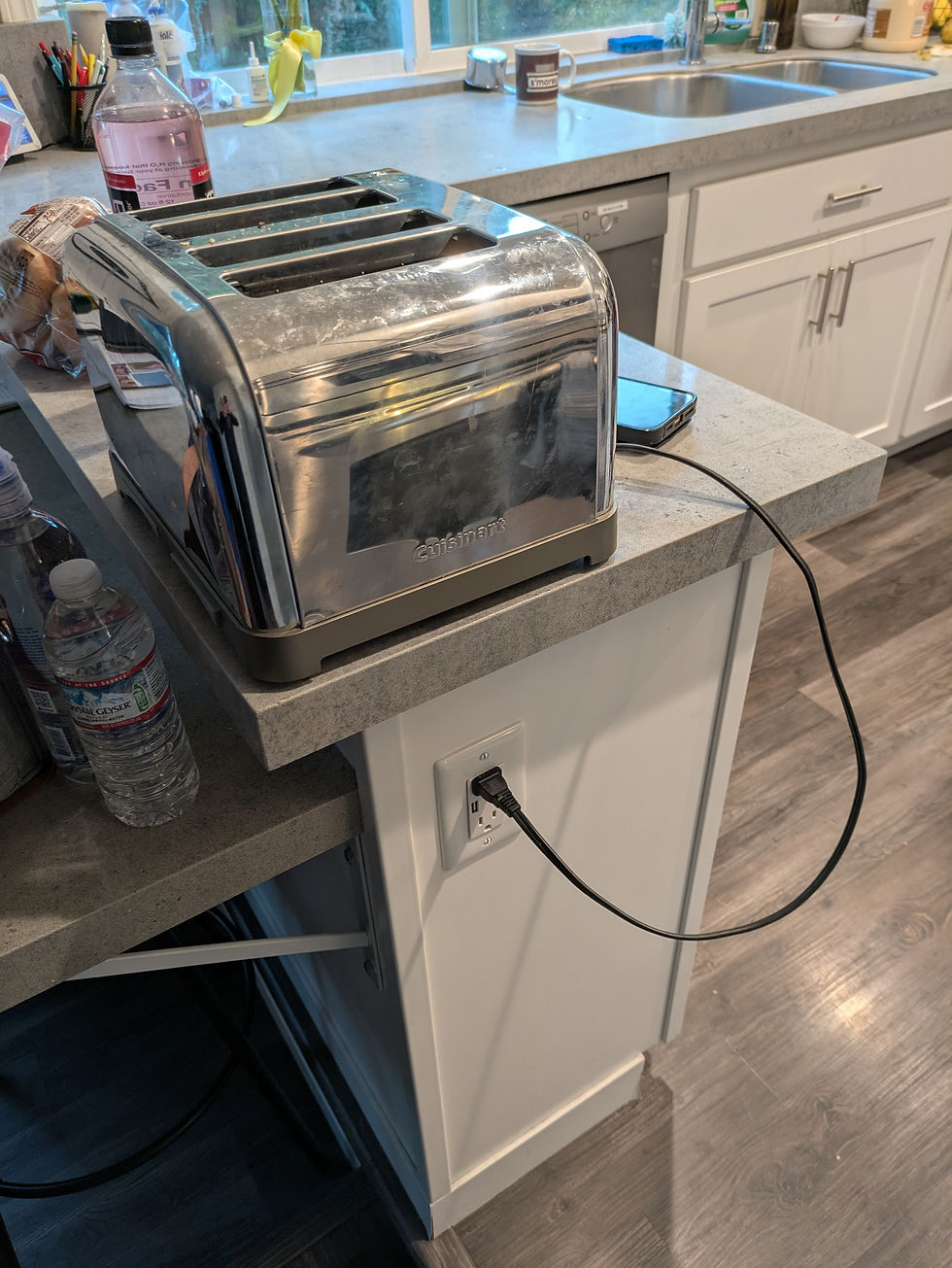The Hidden Dangers of Cabinet Face-Mounted Kitchen Outlets
- Daniel Otts
- Aug 20
- 4 min read

You know those sleek receptacles mounted on the face of a kitchen island or peninsula cabinet—right under the countertop overhang? I just posted a photo of my own toaster plugged into one I installed for convenience. It works. It also quietly introduces a hazard most homeowners (and a lot of pros) don’t think about: cord overhang.
When an appliance cord drapes across the cabinet face and over the countertop edge, it becomes easy for a child to tug—or for an adult to snag it with a hip, bag, or dish towel—pulling a hot appliance or scalding liquid off the counter and onto a person.
Why Cord Overhang Matters (and Who’s Most at Risk)
Small movements can translate into big injuries when heat is involved. Children are especially vulnerable because cords are at their eye-level and within reach as they walk past an island or peninsula.
CPSC’s injury surveillance (NEISS) specifically tracks scald burns from hot liquids and steam; pediatric scalds at home are a persistent, well-documented problem. Independent analyses of CPSC NEISS data show that, in non-fire cooking incidents from 2013–2017, children under five represented a large share of the emergency-department cases, with hot foods and liquids driving the injuries.
What the Codes and Safety Community Have Been Signaling
This isn’t just a theoretical hazard. The 2023 National Electrical Code (NEC) removed the old requirement to put receptacles on island/peninsula sides and shifted toward keeping outlets on or above the countertop—precisely to reduce trailing cords and the pull-down risk.
If outlets are installed to serve an island/peninsula today, the NEC directs them to be on/above the surface (or in listed in-counter/worksurface assemblies), not below the overhang. The National Fire Protection Association highlighted that this change followed years of burn incidents involving toddlers.
“It’s Just a Toaster”… Except When It’s Not
Coffee makers, kettles, instant-ramen cookers, air fryers—many countertop appliances contain water or oil hot enough to cause second- or third-degree burns.
CPSC recall files are full of burn-hazard notices for hot-beverage appliances when something goes wrong (think: expelled hot water, failed handles, or ruptured pods). Even when the product itself is fine, a cord yanked from below-counter height can tip a machine or slosh its contents onto whoever is standing there.
Quick Safety Self-Audit You Can Do Today
Identify any below-counter/face-mounted receptacles that serve your island or peninsula. If you regularly plug in heat-producing appliances there, you have a pull-down pathway.
Watch the cord path. If the cord crosses the cabinet face or dangles near little hands—or if you find yourself walking past it while prepping—assume it’s a matter of time before it snags.
Consider who uses the space. Homes with kids, grandkids, pets, or frequent guests have a higher interaction rate with that cord.
Safer, Code-Aligned Options
Move power up: Add a receptacle on/above the countertop within the NEC’s 20-inch allowance, or use a listed, flush in-counter/worksurface outlet. These keep cords on the surface and out of reach.
Stage appliances differently: Keep hot-liquid appliances away from edges and traffic lanes; route cords so they don’t cross walkways or hang.
Use cord discipline: Shorter cords, cord clips, or channels that keep slack on the counter—not over the edge.
Reserve below-counter outlets: Use them for low-heat, low-risk devices (chargers, under-cabinet lights, vac docks), not kettles or coffee makers.
What About Existing Cabinet-Face Outlets?
You don’t have to tear your kitchen apart. Many homeowners simply stop using those outlets for hot appliances.
If you’re remodeling or already opening walls, ask your electrician to add a surface-level receptacle or a listed in-counter/worksurface unit and cap the below-counter one (or leave it for non-hazardous loads). The point is to align your usage with how the safety community and code writers now expect islands to be used—cords stay on the counter, not over the edge.
The Bigger Picture: Why Vigilant Inspection is Flagging This
As inspectors, we look beyond “does it work?” to “could it hurt someone?”
CPSC’s surveillance program processes ~400,000 product-related injury cases annually across U.S. hospitals—burns and scalds from everyday kitchen activity are a steady slice of that reality. The combination of heat + height + cord overhang is a foreseeable hazard we can reduce with small layout changes.
Bottom Line
Cabinet face-mounted receptacles under a countertop overhang are convenient—but they encourage cord paths that make it too easy to pull hot appliances and liquids off the counter.
Modern code guidance and burn-injury data both point the same way: keep outlets where cords stay on the surface, and keep heat away from the edge. If you want a quick walk-through of safer outlet locations in your kitchen—or you’re planning a remodel—Vigilant Inspection can help you choose options that fit your space and the latest safety thinking.
Sources & Further Reading
National Fire Protection Association: Why the NEC changed island/peninsula outlet rules and the burn-injury problem that drove it.
NEC 2023 summary of island/peninsula receptacle placement (on/above counter or listed in surface).
CPSC: NEISS system and scope of product-related injury surveillance (~400k cases/year).
Analyses drawing from CPSC NEISS data on non-fire cooking burns and under-five injuries.
CPSC recalls illustrating hot-liquid burn hazards from countertop appliances (recent coffee maker recall example).
Note: Local code adoption varies. Always consult your local building department and a licensed electrician before modifying electrical systems.
Comments